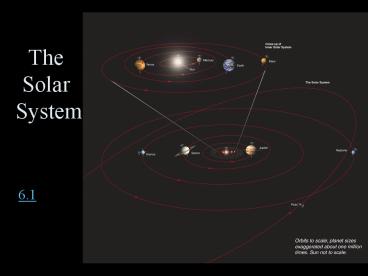The Solar System PowerPoint PPT Presentation
1 / 24
Title: The Solar System
1
TheSolar System
6.1
2
The Sun
- This is the part of the solar system well talk
about in detail next week - However, a couple useful stats are
- 100 x size of Earth
- 3x105 x mass of Earth
- Earth and Moon orbiting Earth would fit IN the
sun - Surface temp 5800 K
- much hotter inside
3
Mercury
0.39 AU Radius2,440 km Mass0.055
(Earth1) Density 5.43 (H201) Rocks/Metals
(mostly iron) Temp100-700 K Moons0
- No atmosphere
- Not much info on Mercury
4
Venus
0.72 AU Radius6,051 km Mass0.82 Density5.24 Roc
ks/Metals Temp740 K Moons0
Thick atmosphere ? lots of pressure ? Also
difficult to see through (used radar) Odd axis
of rotation (backwards/clockwise)
5
Earth
1 AU Radius6,378 km Mass1. Density5.52 Rocks/Me
tals Temp290 K Moons1
6
Mars
1.52 AU Radius3,397 km Mass0.11 Density3.93 Roc
ks/Metals Temp240 K Moons2 (SMALL!)
Dry ice polar caps?
Spirit and Opportunity
APOD
7
Jupiter
5.2 AU Radius71,492 km Mass318 Density1.33 H,
He Temp125 K Moons63 in 3 groups
NASA
- Liquid/Metallic Hydrogen
- Red Spot
- Active volcanos on Io
- Liquid water on Europa
APOD
8
Saturn
9.54 AU Radius60,268 km Mass95.2 Density0.70 H,
He Temp95 K Moons31
Rings Slowly evolving Made up of various sized
bits of rock and ice
9
Credit Cassini
10
Uranus
- Axis of rotation tilted 90 deg
- Methane, water, and ammonia
19.19 AU Radius25,559 km Mass14.5 Density1.32 H
,He,H-comp Temp60 K Moons27
11
Neptune
30.06 AU Radius24,764 km Mass17.1 Density1.64 H
, He, H-comp Temp60 k Moons13 Triton (largest
moon) rotates the wrong way
12
Pluto
- Icy composition
- Smaller than our moon
- Charon is half the diameter of Pluto
39.54 AU Radius1,160 km Mass0.0022 Density2.0 I
ces,Rock Temp40 K Moons1(3?)
HST image of Pluto and Charon ? we dont have
much information on Pluto (New Horizons is on its
way)
13
Is Pluto a Planet?
- Planet
- A nonluminous celestial body larger than an
asteroid or comet, illuminated by light from a
star, such as the sun, around which it revolves.
In the solar system there are nine known planets
Mercury, Venus, Earth, Mars, Jupiter, Saturn,
Uranus, Neptune, and Pluto. - One of the seven celestial bodies, Mercury,
Venus, the moon, the sun, Mars, Jupiter, and
Saturn, visible to the naked eye and thought by
ancient astronomers to revolve in the heavens
about a fixed Earth and among fixed stars. - One of the seven revolving astrological celestial
bodies that in conjunction with the stars are
believed to influence human affairs and
personalities.
http//research.amnh.org/users/tyson/essays/Plutos
Honor.html
http//astrobulletin.amnh.org/D/4/5/
14
Another Planet?
http//science.nasa.gov/headlines/y2005/29jul_plan
etx.htm
Moving downwards in the image
Estimated 1.5x size of Pluto Currently at 97 AU
(in the Kuiper Belt)
15
Why Do We See The Planets
- Sure, we produce lots of light pollution on
Earth, but who left the lights glowing on Mars? - Two ways we see planets (wavelengths?)
- Reflecting sunlight Albedo (next slide)
- Blackbody emission yup, it works for planets
too! - Many radio/sub-mm telescopes use the planets to
calibrate brightness
Click Here
16
Albedo
The ratio of light reflected from an object
divided by the light that hits the object.
Albedo equals zero for perfectly black and one
for perfectly white.
17
Observations of the Solar System
NASA has always been geared towards exploration
of the solar system. Dozens of probes have been
sent to get better views of the planets and their
moons. Fly-bys, orbiters, landers and probes.
An excellent resource for information on
missions to the planets is http//www.planetary.
org/learn/missions/
18
General Motion of the Planets/Moons
- Nearly circular orbits
- Orbits lie nearly in the same plane
- All orbit in the same direction
(counterclockwise) - Most planets orbit in the same direction they
revolve - Most of the large moons behave similarly to the
planets
19
Classifying the Planets
- Jovian Planets
- Composed of H, He, H-compounds
- Larger in size
- Lower density
- Further from the Sun
- Numerous moons
- Terrestrial Planets
- Rocky surfaces, abundance of metals
- Smaller in size
- Higher density
- Closer to the Sun
- Few or no moons
What about other objects in the solar system?
20
Asteroids
Old theories claim a planet existed in the
asteroid belt and was destroyed no good
evidence for this. However, it is conveniently
located at the Frost Line (more on this later)
which is just past Mars
21
Comets
Clouds of dust and gas (the coma), overall size
can be 1 AU! This is just dust/gas being blown
from the very small (10 km) icy nucleus.
2 types of tails Gas glowing and interacting
with solar wind Dust reflects sunlight towards
us
22
Nucleus of a Comets
Deep Impact collided with Tempel 1 last 4th of
July. Stardust returned recently with a sample
of comet Wild 2.
The Nucleus of Comet Tempel 1 Credit Univ.
Maryland, JPL-Caltech, NASA
23
Comet Shoemaker-Levy 9The String of Pearls
24
Main Features of the Solar System
- Orderly motions of planets and moons
- Two categories of planets
- Lots of asteroids and comets
- Exceptions to the rule (our moon, rotation axis
of Uranus and Venus) - So, how can we explain these common traits as
well as the exceptions

